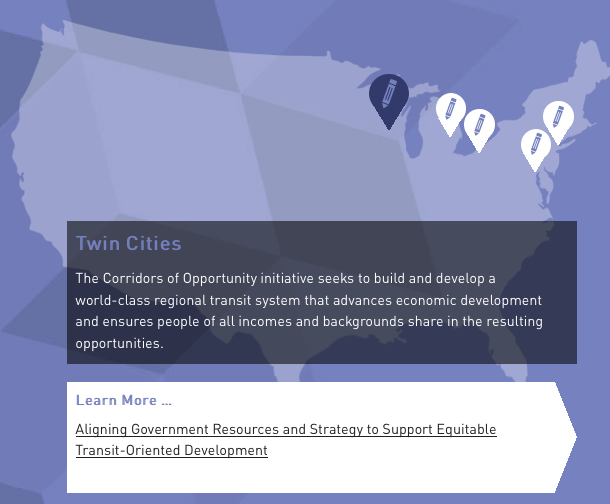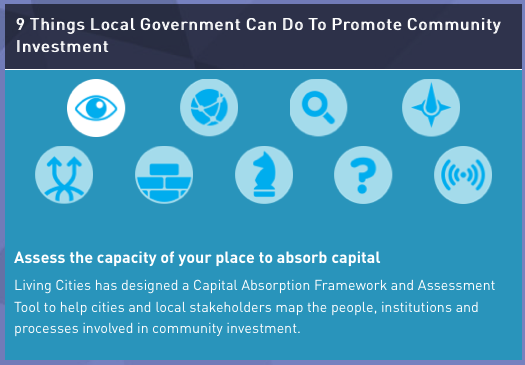THE LIVING CITIES
A New Way To Solve Complex Problems
Collaborative Change
Isolated approaches to fixing our most intractable problems, like growing economic disparity and failing systems, have not worked. We need new, local, integrative collaborative change models where cross-sector decision-makers come together to:
- Set ambitious goals
- Use data to transform systems, and
- Achieve better outcomes
Through the Integration Initiative and the Strive Network, Living Cities is supporting this type of civic infrastructure across the country. It’s helping us to understand how local leaders can achieve and sustain unprecedented alignment. And we’re learning how we can accelerate the adoption of innovation in more places by intentionally bringing cities together.
The Integration Initiative
Living Cities began working in 2010 on our signature effort, The Integration Initiative (TII), to adapt the Strive collaborative leadership framework to stimulate systems change in workforce (Baltimore), economic development (Cleveland), urban revitalization (Detroit), equitable transit-oriented development (Twin Cities) education, and health (Newark). In these cities, we are helping aggregate local talent, knowledge and dollars; integrate leadership across multiple sectors; and drive private capital to work on behalf of low-income people. The Living Cities Catalyst Fund provided $16 Million in flexible lending dollars to support these local initiatives and test new models for aligning capital with the systems change priorities.
After just two years, we have gleaned important lessons on realigning institutions across issues, sectors, and disciplines. We also have seen significant evidence pointing to enduring change. In the Twin Cities, for example, five local and state funding streams have been permanently redirected to support the build out of a light rail transit system that will increase low-income residents’ mobility.
By creating a robust information sharing capability among the cities and a forum for teams from each city to come together with each other throughout the year, ideas quickly spread from place to place. And we have been able to see patterns that we had never been able to see before.
Strive
At the root of many American problems lies an ineffective and outdated education system that is failing our students. Inequality and education have always been inextricably linked, and if we don’t fix education, we don’t fix inequality. Simply put, our citizens are not being prepared to compete in today’s global, hyper-connected economy, and, for low-income students, the outlook is especially grim.
To date, most efforts to fix the education have been piecemeal, focusing intensively on improving 3rd grade reading levels, for example, and ignoring sinking high school graduation rates. The Strive Partnership – founded in Cincinnati and Northern Kentucky in 2006 – has taken a very different approach. Strive brings private, public, philanthropic and nonprofit leaders together to agree upon definable goals in each stage of development, from cradle to career. They then use real time, annual data on outcomes to coordinate action and align their collective dollars to hit the targets. In just six years, they have moved the needle, including a 13% increase in school readiness, a 16% increase in 4th grade reading levels, and a 7% increase in college enrollment.
After working with Strive to understand the transferability of this framework in Houston, Richmond, Portland and the Bay Area, Living Cities support has helped Strive to build the Strive Network. The Network is helping similarly ambitious cities to come together, support each other and share what’s working. In less than 2 years, the framework for change promoted by the Strive Network has been adopted by 80 sites nationwide.
Read full report here: The Network Effect
About The Living Cities
www.livingcities.org
“Founded in 1991, Living Cities is an innovative collaborative of 22 of the world’s largest foundations and financial institutions. In nearly 20 years Living Cities members have collectively invested almost $1 billion, helping shape federal funding programs, redirecting public and private resources, and helping communities to build homes, stores, schools, community facilities and more. However, our members are not simply funders. They shape our work and priorities by participating on the Living Cities Board of Directors, four standing committees and three working groups. In sum, our members contribute the time of 80-plus expert program staff toward improving the lives of low-income people and the cities where they live.”
Tags: community investment, Data, problems, solving, The Living Cities, The Network Effect








 RSS Feed
RSS Feed